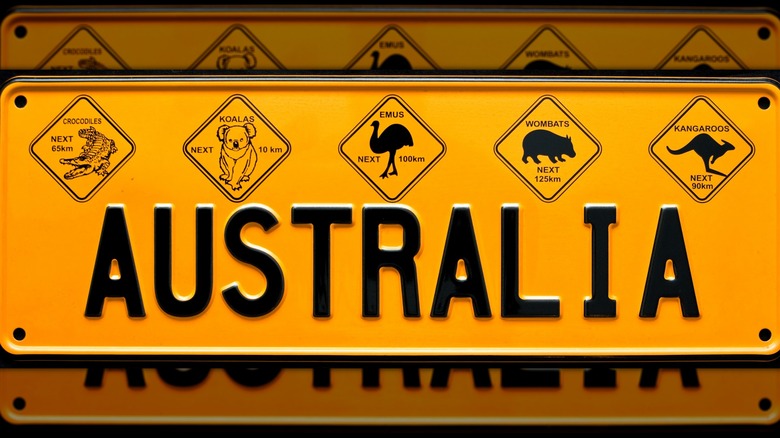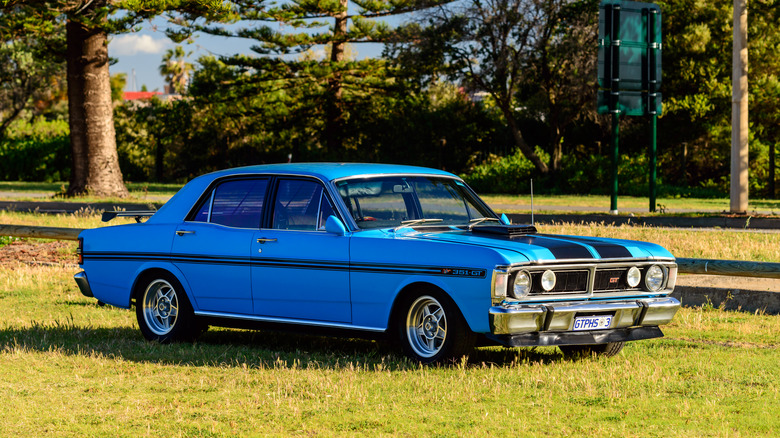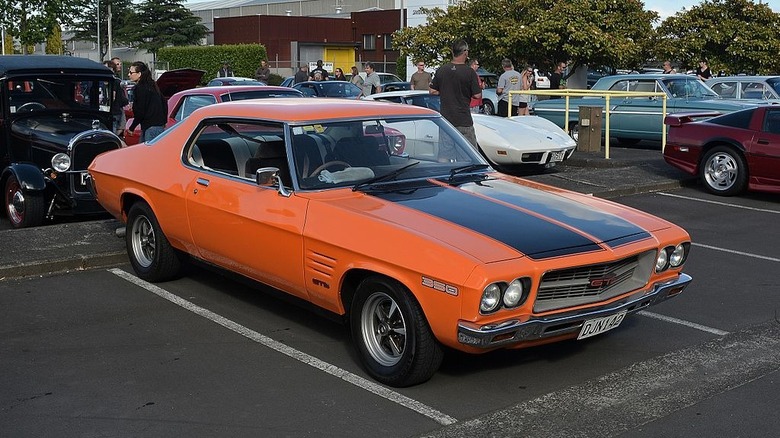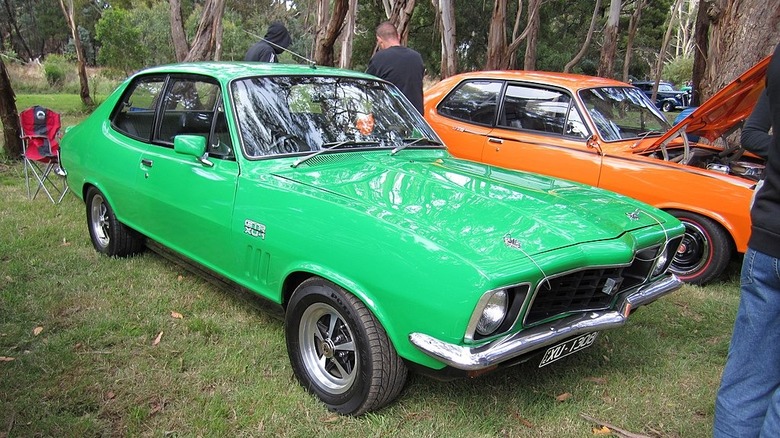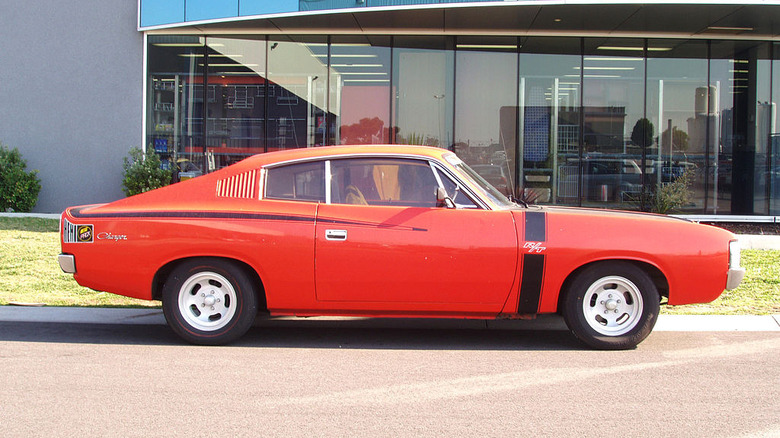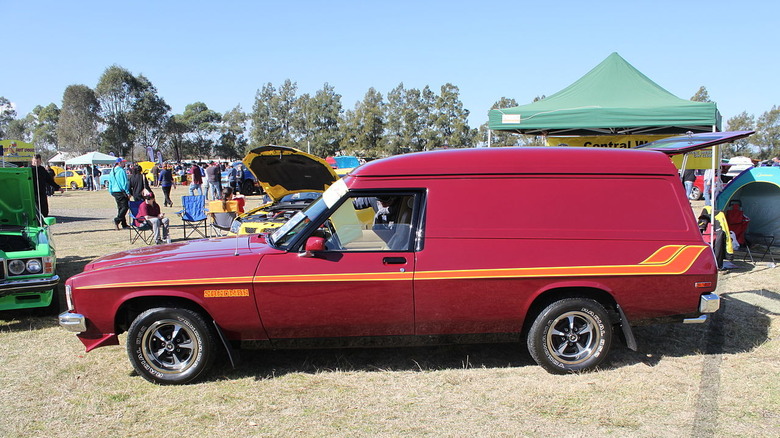5 Of The Coolest Australian Muscle Cars Ever Built
Muscle cars may have been born in America, but the Big Three (Ford, General Motors, and Chrysler) all had car-making divisions worldwide ready to bang out unique road ragers to the locals, including in the land down under. Ford started making cars in Australia in 1925, and General Motors Australia was created in 1926.
The consensus is America's golden age of muscle cars started around the mid-1960s and lasted until the early '70s. Australia's was similar from 1967 to 1972. The global oil crisis hampered its muscle madness, but a "Supercar Scare" was also to blame.
In June 1972 a newspaper article touted the arrival of "supercars" that would go 160 mph on public streets. Local motor racing at the time had a homologation rule, which required cars used to race to have a street-spec version. Fear gripped the public with visions of hooligans ripping up roads.
Lawmakers felt pressured to assuage those fears and threatened to drop the ban hammer. Racing authorities tweaked the rule and allowed manufacturers to modify production-based cars for racing, so "supercars" never reached the roads, but street-focused rods did. Here are some of the best Australia had to offer.
Ford Falcon GT
According to some sources, Australia's first muscle car was the Ford Falcon GT. Ford introduced an XR series of Falcons in 1967, including a performance version badged XR GT. Aussie auto nomenclature is more confusing than America's, and the Falcon line had XA, XB, XC, XT, XY, XW (with HOs thrown in for good measure), and even "Phase" variants.
The XR GT was powered by a police-spec'd engine from a Mustang (4.7-liter, 289 ci, V8 with a four-barrel carb producing 225 hp), but was saddled with four doors, which most American hot rodders refused to label a "muscle car" since it wasn't a coupe. Despite the tag, it was the first "shots fired" and a brouhaha began with Chrysler's Holden division.
Between '68 and '71 various souped-up versions were released, many backed by a 5.8-liter, 351 Cleveland V8 listed as making 300 hp but pegged at 350 hp from first-hand accounts. Its first homegrown fair dinkum (Oz slang for "genuine") model was the '72 XA Falcon, and the first time it came as a two-door coupe. The GT HO variant had a top speed of 142 mph and did zero to 60 in 6.4 seconds, making it the fastest four-door in the world.
Then we come to the magnum opus that might top the list as coolest movie muscle on the planet — the 1973 Ford Falcon XB GT Coupe. Better known as the V8 Interceptor or Pursuit Special, the Falcon was the car driven by "Mad Max" across the dusty Outback. Sadly, the whole "Supercar Scare" was at its peak, and it was discontinued in '73.
Holden Monaro GTS
In response, General Motor's Holden plant flexed its muscle in 1978 with the pillarless hardtop Monaro coupe available in a base package, the GTS version, and the GTS 327. During its first generation, which lasted through 1971, the Monaro had three models: HK, HT, and HG.
The HK GTS 327 was packed with a Chevy-sourced 5.4-liter V8 rated at 250 hp and was fast enough to come in first, record the fastest lap, and beat out all of Ford's Falcons at the then-named Hardie-Ferodo 500, which is now the Bathurst 1000. The year before, a Falcon won that race.
The '69 model received a new name (the HT series) and a new look. The GTS 350 was strapped with a heavy-duty suspension and bigger brakes, which made it handle better than its HK forefather. It was also powered by a significantly larger 5.7-liter V8, kicking out 300 hp. This bigger block pushed the car to a 15.7-second quarter mile and had a top speed of nearly 130 mph. Despite not recording the fastest lap time, the HT 350 won the 1969 Hardie-Ferodo 500, and in 1970 took first at the Australian Touring Car Championship.
In a move that raised some eyebrows, the 1971 HG model lowered the performance bar and wasn't as attractive as the HT. What's more, the hp in the GTS 350 version dropped to 275.
[Featured image by GPS 56 via Wikimedia Commons | Cropped and scaled | CC BY-SA 2.0]
Holden Torana GTR XU-1
GM Holden replaced the Monaro as its primary racer with the LC Torana GTR XU-1 in 1970 and is why the '71 Monaro was so lackluster.
It was unlike the Morano, which was powered by a huge V8. The Torano packed a more demure 3.0-liter straight six-cylinder fed by a trio of Stromberg carburetors. It produced only 158 hp, roughly half what the Monaro GTS 350 could. Nevertheless, Holden got away with the mini motor because the Torana was nimble. It won several rally titles, and six of the top 13 vehicles at the Hardie-Ferodo 500 in 1970 were Toranas.
Ironically, the Torana would lead to the development of GM's T-car, better known to American car buyers as the (doomed from the start) Chevrolet Chevette.
When the LJ dropped in 1972, the engine had increased to 3.3 liters (keeping the three Stromberg carbs), which boosted horsepower to 190. A softer suspension and nicer seats were added for the roadworthy model. The tweaked racing version was equipped with a lighter flywheel and hotter camshaft, giving it a time of 15.2 seconds on the quarter mile and a top speed of almost 137 mph. A Torana took first in the Hardie-Ferodo 500 at Bathurst in 1972.
The '74 TA Torana was finally equipped with a 5.0-liter (308 ci) V8 that produced 240 hp.
[Featured image by Sicnag via Wikimedia Commons | Cropped and scaled | CC BY-SA 2.0]
Chrysler Valiant Charger
When Chrysler's two-door Valiant Charger came out in 1971, it was late to the party with Ford and GM Holden releasing muscle cars sooner. The Charger was based on the Valiant sedan, a variant of Plymouth's Valiant and Dodge Dart, thus making them interrelated. However, while the Aussie version of the Charger took its name from its American kin, the body was made for Australia.
The power plant in the R/T model was a 4.3-liter (265 ci) "Hemi 6," yet another thing that was distinctive to this version of the Charger. This inline six-cylinder had a triple-carb "six pack" and was so magnificently tuned it pushed out 302 hp, which was unheard of for six cylinders. It went from zero to 60 in six seconds, half a second faster than a V12 Ferrari Daytona.
Meanwhile, the luxury-oriented Charger 770 SE was rocking a 5.6-liter (340-cid) V8 — kicking out 275 hp — found in Chrysler's smaller American muscle cars, but due to the SE's bulk plus its single exhaust and automatic transmission made it slower than the six cylinders.
In 1973, a VJ-series was unleashed with a 5.9-liter 360 ci V8 (with a two-barrel carb), producing a much less 255 horsepower. That was followed in '75 by the VK (with an even more neutered version of the 360 ci V8). When the last Valiant Charger rolled out in '78, it was sporting a 5.2-liter 318 ci V8 with a four-speed manual transmission.
[Featured image by Chris Keating via Wikimedia Commons | Cropped and scaled | CC BY-SA 2.0]
Holden Sandman
This sports coupé utility car panel truck van is the Sandman. If you parked the Ute version (an open bed without the panel van top) next to a Chevy El Camino, you'd be forgiven for thinking they are the same. The van top added that whole "shaggin' wagon" vibe to the Sandman but was otherwise a blank canvas. It would fit surfboards, work equipment, bean bag chairs, and a bed. It was business in the front, party in the back.
Another feature that made the Sandman unique was the "Radial Tuned Suspension," which, as the name implies, had a suspension (coil springs in front, leaf springs at the back) specifically tuned to its radial tires. The anti-dive technology, front and rear stabilizer bars, and Panhard rod rear-end (used to control the rear axle's lateral movement) worked together with the tires to ensure it handled well given its odd shape and size.
Engine options included a 2.8 and 3.3-liter six-cylinder, or wo V8s – the 4.2-liter 253 ci and a powerful 5.0-liter 308. Horsepower ranged from 108 (in the 2.8) to 215 (in the 308, which had a top speed of 125 mph). Transmission options also ran the gamut between a three or four-speed all-synchromesh manual or a three-speed tri-matic automatic.
[Featured image by Jeremy via Wikimedia Commons | Cropped and scaled | CC BY-SA 2.0]
